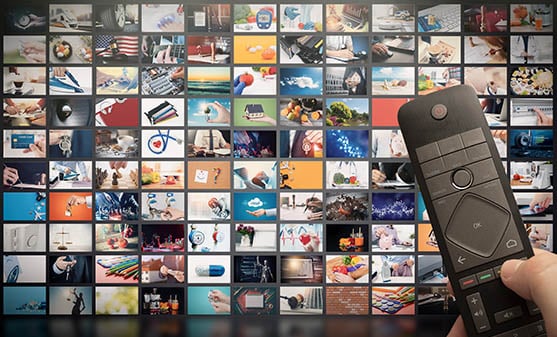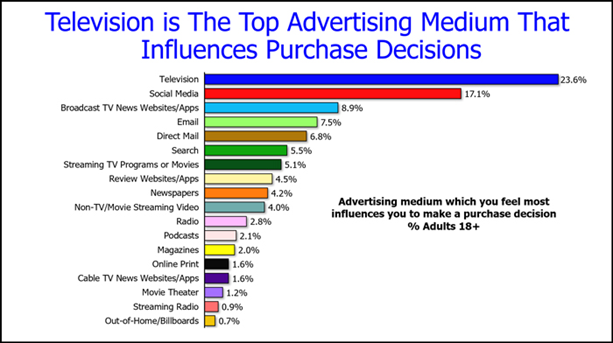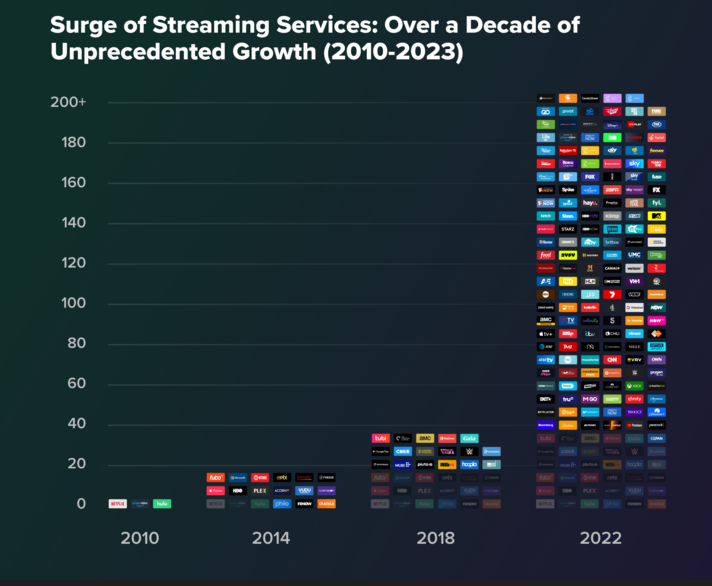Will Video Streaming Kill Traditional TV and Cable?
Current state of video streaming and its effect on TV and cable

Before smartphones and tablets, people enjoyed a different favorite pastime, watching TV. For almost 50 years, TV – network and cable -- captured the world’s attention by delivering prime programming, live sports, and breaking news. For advertisers looking to reach large audiences with a broad demographic, television was the way to go.
However, that’s no longer the case with the rise of smart televisions and streaming services.
TV viewership is declining, primarily driven by younger audiences favoring streaming services. Over 60% of individuals under 30 prefer online streaming over watching live television. The media landscape has become fragmented due to the many user-controlled viewing opportunities available to the consumer, represented by Over-the-Top TV (OTT), Connected TV (CTV), and Linear TV.
Before going further, let’s define that alphabet soup since these may be new terms.
- OTT offers live or on-demand video streaming services, which deliver content over the internet, bypassing the need for a cable or satellite provider. Think Netflix, Hulu or Prime Video.
- CTV brings OTT to the screen. It refers to any television set connected to the internet that allows users to stream OTT content. Examples include Smart TVs, streaming devices like Roku, Apple and Amazon Fire Stick and gaming consoles.
- Linear TV also known as live television, is your traditional antenna, cable or satellite option where viewers watch at a specific time to catch a favorite show or live sports. Think of ABC, NBC, CBS and ESPN.

The reality is streaming is here to stay. Each year streaming services gain additional marketing revenue from advertisers due to their targeting capabilities and detailed user analytics. From 2022 to 2027, it is projected that CTV ad spending will double from $20.69b to $40.90b while linear TV ad spending is expected to decrease from $66.90b to $56.83b.
The big question for advertisers is: What does the future look like for utilizing TV and cable to reach their audiences?
Benefits of Linear TV
There are many reasons why advertisers continue to include linear TV in their media plans. Although the following benefits can apply to all advertisers, the effectiveness of linear TV advertising ultimately depends upon the campaign’s goals, target audience and creative execution.
- Wide Reach: Linear TV can reach a massive audience, making it effective to connect with a broad demographic
- Brand Visibility: Visuals, audio, and storytelling can create a memorable image that will build brand awareness
- Prime Time Exposure: Prime time slots during popular TV shows and events allow advertisers to connect when viewership is at its peak
- Demographic Targeting: Linear TV allows advertisers to target specific audiences based on channels and programs
- Local Opportunities: Linear TV can be a valuable tool for localized advertising through regional or local channels
- Impact on Consumer Behavior: Linear TV advertisements can influence consumer behavior, such as driving sales, website visits or other actions
Regarding the impact on consumer behavior, the 2023 Media Comparisons Study, conducted by GfK, found that TV is the top advertising medium for purchase influence and motivating respondents to learn more about products.
Streaming’s impact on cable
In the early 2010s, the cable TV industry was booming. Over 105 million U.S. TV households subscribed, and cable boasted a penetration of over 90% of TV homes. By 2012, the number of scripted entertainment shows on cable (125), surpassed TV (119), peaking at 189 by 2015.
However, the demise of cable TV is coming sooner than expected, largely due to competition from streaming services. According to Nielsen, this past July, for the first time, TV and cable combined made up less than 50% of total viewership, a record low. This is in part due to cable companies offering a streaming version or partnering with YouTube to replace their TV service. Also, entertainment companies such as Disney and Warner Bros., are leaving cable TV to build and grow their streaming services. Additionally, two factors – faster internet speeds and overall dissatisfaction with cable providers – boosted streaming’s popularity over cable. As platforms rebrand and build content, this is becoming an era that changes how and what we watch. Streaming services have surged to more than 200 operating globally over the past decade.
For cable companies to survive, they will need to find a balance between developing their own streaming platforms and acquiring more customers to maintain the old cable TV contracts that have carried them thus far.
Options mean more flexibility for advertisers
You may be asking yourself, with so many options, where is the best place to put my advertising dollars? That’s a good question. There are benefits and drawbacks to each.
Unlike linear TV advertising, OTT ads are more seamlessly integrated into the user’s watching experience and viewers know exactly how long they will last. Advertisers can target consumers where they may be, no matter what they’re watching or what platform, providing invaluable online consumer behavior. But with the good comes the not-so-good. OTT’s limited scale means advertisers pay more for impressions over digital video and linear TV.
CTV also offers advertisers numerous benefits. Brands can get in front of the right audience at the right time and capitalize on user-registration data. This allows for cross-screen targeting and IP-based delivery that permits the application of first and third-party audience data to target households watching ad-supported content. Although CTV advertising has been growing rapidly in recent years, it still faces some challenges. Just like OTT, CTV’s fragmented space can make it challenging for advertisers to reach their target audience efficiently.
Although linear TV advertising has extensive reach and scale, there is a lack of accurate and real-time measurement as TV relies on estimated viewership data and post-campaign analysis, making it hard to optimize while live. Compare that to CTV, which offers a personalized viewing experience by connecting brands with viewers in a more intimate and targeted way. CTV can provide measurement and analytic capabilities within minutes, allowing advertisers to quickly optimize campaigns.
Meanwhile, cable’s targeted solutions offer advertisers the opportunity to reach hyper-local audiences based on lifestyles or interests. Through cable, advertisers have the option to target ads based on factors such as demographics, geography, behavior, and more. Ads can also be targeted based on the time of day, day of the week, or even specific programs so that you are reaching your target audience when and where they are most active.
Looking to the future
As technology advances and consumer behavior shifts, CTV and OTT are rapidly emerging as reasonable alternatives to linear TV advertising. However, the future isn’t necessarily a linear TV or digital-only approach, but rather a combination of TV, OTT and CTV to reach an audience with scale and efficiency. To wrap up our learnings, let’s look at those advertising trends to follow in 2024.
- Rise of CTV – As this shift continues, advertisers need to understand how they can use CTV to achieve full-funnel KPIs.
- Free ad-supported streaming (FAST) grows – Subscription-free options with the ability to choose a channel to watch whatever is scheduled are becoming popular amongst budget-minded consumers. This benefits the advertiser in delivering non-skippable, premium ads that will be seen.
- CTV gets local – As more TV viewers migrate to CTV, advertisers can take advantage of precise targeting capabilities to execute campaigns with local precision at a national scale.
- Integrating AI into TV advertising – Leading AdTech providers are utilizing AI and machine learning technologies that analyze massive amounts of data to drive split-second decisions about the best available opportunities.
It's important to note that the future of TV advertising will be influenced by a dynamic and evolving media landscape. The predictions above reflect ongoing trends, but the industry will continue to adapt to emerging technologies and changing consumer behavior.
Looking to get started with a digital media plan? We can help! Take a look at our blog that provides tips on how to successfully prepare for a digital marketing plan here and then drop us a note to get started.
Never miss an article.
Get the latest sent straight to your inbox.
Related Articles
Leveraging the versatility of radio marketing strategies



